
INDEX | HEALING WISE | Q & A with SUSUN | GREEN BLESSINGS
THE LIBRARY | PEOPLE MAKING CHANGE | GODDESS ART GALLERY
Healing Wise ...
with Susun Weed
Spirit of Simples
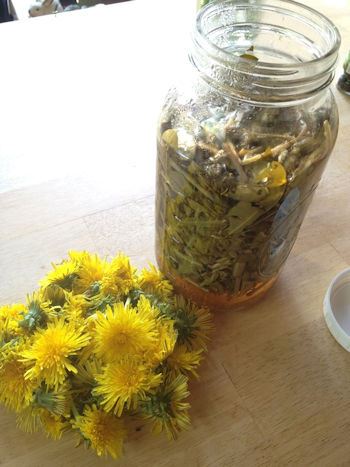
What is a Simple?
A "simple" is one herb used at a time. A "simpler" is an herbalist who generally uses herbs one at a time, rather than in combinations.
Why Use Simples?
Most herbalists I have met -- whether from China or Japan, Eastern or Western Europe, Australia or North America -- use herbs in combinations. Simplers, like myself, don't. Why?
Because I believe that herbal medicine is people's medicine, I seek to make herbal medicine simple: as simple as one herb at a time. Because people worry about interactions between the drugs they take and herbs, I keep it simple: with simples, interactions are simple to observe, and simpler to avoid. Because empowerment in health care is difficult, I want to offer others easy, safe herbal remedies: and what could be easier, or safer, than a simple?
When I was just getting started with herbs, one thing that confounded me was the many choices I had when I began to match symptoms to the herbs that relieved them. If someone had a cough should I use garden sage or wild cherry bark or pine sap or mullein or coltsfoot (to name only a few of the many choices)? One way out of this dilemma was to use them all. I made many cough syrups that contained every anti-cough herb that I could collect. And they all worked.
As I got more sophisticated in my herbal usage, and especially after I completed a course on homeopathy, I began to see that each herb had a specific personality, a specific way of acting. I realized I couldn't notice the individual actions of the herbs when they were combined.
It felt daring at first to use just one herb. Would wild cherry bark tincture all by itself be enough to quell that child's cough? Yes! Would mullein infusion alone really reduce a person's asthmatic and allergic reactions? Yes! Would sage soaked in honey for six weeks ease a sore throat? Yes! Each herb that I tried as a simple was successful. They all worked, not just together, but by themselves.
The more I used individual herbs the more I came to know them as individuals. The more I used simples, the simpler and more successful my remedies became. The more I used one herb at a time, the more I learned about how that herb worked, and didn't work.
When we use one herb at a time, we come to know that herb, we become intimate with that herb. Just as we become intimate with each other by spending time one-on-one, tete-a-tete, simply together, we become closer to the herbs when we use them as simples.
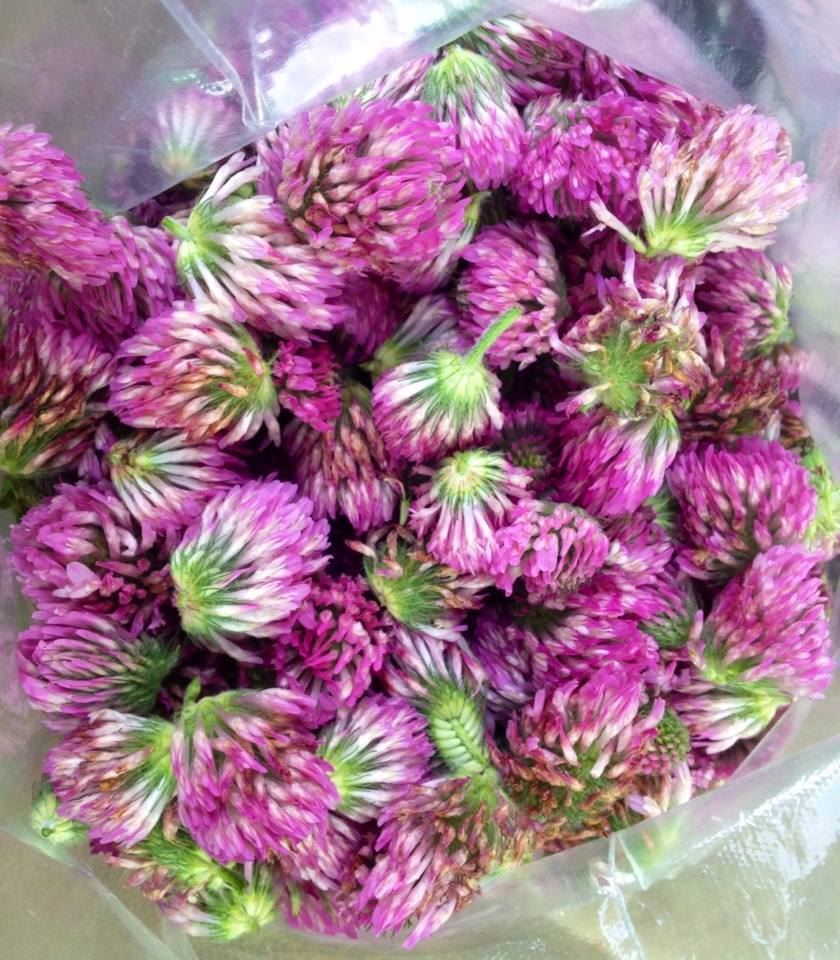 Becoming intimate with an herb or a person helps us build trust. How reliable is the effect of this herb? When? How? Where does it fail? Using simples helps us build a web of green allies that we trust deeply. Simples help us feel more powerful. They help abate our fears, simply, safely. Becoming intimate with an herb or a person helps us build trust. How reliable is the effect of this herb? When? How? Where does it fail? Using simples helps us build a web of green allies that we trust deeply. Simples help us feel more powerful. They help abate our fears, simply, safely.
Using one herb at a time gives us unparalleled opportunities to observe and make use of the subtle differences that are at the heart of herbal medicine. When we use simples we are more likely to notice the many variables that affect each herb: including where it grows, the years's weather, how we harvest it, our preparation, and the dosage.1 The many variables within one plant insure that our simple remedy nonetheless touches many aspects of a person and heals deeply.
One apprentice tinctured motherwort flowering tops weekly through its blooming period. She reported that the tinctures made from the younger flower stalks had a stronger effect on the uterus; while those made from the older flower stalks, when the plant was going to seed, had a stronger effect on the heart.
Using one herb at a time helps me feel more certain that my remedy has an active value, not just a placebo value. Using one plant at a time, and local ones at that, reassures me that my herbal medicine cannot be legislated away. Using one plant at a time allows me to build trust in my remedies. Using one plant at a time is a subversive act, a reclaiming of simple health care.
Combinations erode my power, activate my "victim persona," and lead me to believe that herbal medicine is best left to the experts.
From Complex to Simple
Take the challenge! Use simples instead of complex formulae. Let's rework some herbal remedies and get a sense of how simple it can be.
The anti-cancer formula Essiac contains Arctium lappa (burdock), Rheum palmatum (rhubarb), Ulmus fulva (slippery elm), and Rumex acetosella (sheep sorrel). Rhubarb root has no possible use against cancer; it is a purgative whose repeated use can "aggravate constipation." Slippery elm bark also has no possible anti-cancer properties and has no doubt been added to counter some of the detrimental effects of the rhubarb. Sheep sorrel juice is so caustic that it has been used to burn off skin cancers, but it would likely do more harm to the kidneys than to any cancer if ingested regularly. Leaving us with a great anti-cancer simple: burdock root. One that I have found superbly effective in reversing dysplasias and precancerous conditions.
A John Lust formula for relief of coughs (2) contains:
Agropyron repens (witch grass)
Pimpinella anisum (aniseed)
Glycyrrhiza glabra (licorice)
Inula helenium (elecampane root)
Pulmonaria officinalis (lungwort)
Thymus species (thyme herb)
(murillo bark)
(3) Chondrus crispus (irish moss)
Lobelia inflata (lobelia herb).
- Witch grass has little or no effect on coughs; it is an emollient diuretic whose dismissal from this group would leave no hole.
- Anise seeds are also not known to have an anti-pertussive effect; although they do taste good, we can do without them.
- Lobelia can bring more oxygen to the blood, but is certainly not an herb I would ever add to a cough mixture, so I will leave it out here.
- Licorice is a demulcent expectorant that can be most helpful for those with a dry cough; however, I do use it for a variety of reasons, among them its exotic origins and its cloyingly sweet taste.
- Lungwort is, as its name implies, a pectoral, but its effect is rather mild, and its place in the Boraginaceae family gives me pause. How much pyrrolizidine alkaloid might it contain?
- Thyme, and its more common anti-cough cousin garden sage, contains essential oils that could both quiet a cough and counter infection in the throat. A strong tea or a tincture of either could be our simple.
- Irish moss is, a specific to soothe coughs and a nutritive in addition, would also make an excellent simple.
- But it is elecampane that I would crown. It is not only a specific to curb coughing, it counters infection well, and tonifies lung tissues. Several small doses of a tincture of elecampane root should quiet a cough in a few hours.
Simples are fun. Give them a try.
Footnotes:
1. Among the many variables, I have especially noticed that the tinctures that I make with fresh plants are many times more effective than tinctures made from dried plants. My elders tell me that preparations of common plants growing in uncommon places will be stronger as well. Many herbalists are aware of certain areas of their land that nurture plants that are particularly potent medicines.
2. John Lust. The Herb Book. 1974. Bantam.
3. Note that this formula, as is frequently the case, contains an "exotic" herb which Mr. Lust does not include in the 500+ herbs in his book, nor does he give us a botanical name for the plant, leaving us literally unable to prepare his formula as presented.
Study with Susun Weed in the convenience of your home! Choose from four Correspondence Courses: ABCs of Herbalism, Green Allies, Spirit & Practice of the Wise Woman Tradition, and Green Witch - includes audio/video tapes, books, assignments, special mailings, plus personal time.
Learn more Here
Natural Approaches to Bladder Infections... the Wise Woman Way
~ Part One ~

Step 1: Collect Information
Bladder infections are also known as cystitis, urethritis, and UTIs (urinary tract infections). When bacteria grow in the bladder, the resulting infection usually causes symptoms such as: a burning sensation during voiding, overwhelming urgency, frequent but minuscule urinations, incontinence, bloody urine, and pelvic pain. Up to 25 percent of bladder infections in post- menopausal women are silent or symptomless.
Bacteria enter the bladder in three primary ways: when feces are spread to the bladder opening (such as wiping from back to front after toileting), when the tube leading to the bladder is irritated or bruised (as from use of a diaphragm, pelvic surgery, or prolonged/vigorous vaginal penetration), or when there is an in-dwelling catheter.
The thinning and shrinking of reproductive and bladder tissues that may occur in the post- menopausal years contributes to bladder infections in older women, as does lessening of vaginal acidity.
Sometimes tiny ulcerations appear in the wall of the bladder; this is called interstitial cystitis (IC). Some of the remedies in this section are contraindicated for women with interstitial cystitis.
These remedies are substantially the same ones that delighted and aided the readers of my first book: Wise Woman Herbal for the Childbearing Year.
Step 2: Engage the Energy
• Flow, flow, flow. Head off that bladder infection by drinking a glass of water hourly as soon as you feel the first urgency or burning. It is tempting to stint on drinking if you find yourself unexpectedly incontinent, but don't. Bladder infections only make incontinence worse.
• Urine is ideally neutral to slightly acidic (pH 5.8–pH 7). Very acidic urine (below pH 5.5) encourages infections. An established infection gives rise to alkaline urine (pH 7.5 or higher), which causes stinging and burning. Test your urine with pH paper at any time except first thing in the morning. Cranberry juice lowers pH; vitamin C raises it.
• Cantharis is a homeopathic remedy for scalding urine.
Step 3: Nourish and Tonify
• Cranberries (Vaccinium macrocarpon) contain substances that kill bacteria and make your bladder wall so slippery that any escaping bacteria can't latch on and thrive there. Unsweetened cranberry juice (or concentrate) is the most effective form. (The sugar or corn syrup in cranberry cocktail-type juices and cran-apple juices can feed the infection.) Drink freely, at least a glass a day, up to a quart/liter a day for acute infections unless your urine's pH is already low.
• Pelvic floor exercises help prevent and relieve bladder infections, too! Try this one: After urinating, close your eyes, relax, breathe out, and see if you can squeeze out an extra dribble.
• An overgrowth of vaginal yeast may be irritating your bladder or urethra. Eat one cup of plain yogurt 4-5 times a week.

|
Susun Weed’s books: |

|
Wise Woman Herbal for the Childbearing Year
Author: Susun S. Weed.
Simple, safe remedies for pregnancy, childbirth, lactation, and newborns. Includes herbs for fertility and birth control. Foreword by Jeannine Parvati Baker. 196 pages, index, illustrations.
Retails for $14.95
Order at: www.wisewomanbookshop.com
|

|
Healing Wise
Author: Susun S. Weed.
Superb herbal in the feminine-intuitive mode. Complete instructions for using common plants for food, beauty, medicine, and longevity. Introduction by Jean Houston. 312 pages, index, illustrations.
Retails for $21.95
Order at: www.wisewomanbookshop.com |

|
NEW Menopausal Years the Wise Woman Way
Author: Susun S. Weed.
The best book on menopause is now better. Completely revised with 100 new pages. All the remedies women know and trust plus hundreds of new ones. New sections on thyroid health, fibromyalgia, hairy problems, male menopause, and herbs for women taking hormones. Recommended by Susan Love MD and Christiane Northrup MD. Introduction by Juliette de Bairacli Levy. 304 pages, index, illustrations.
Retails for $22.95
Order at: www.wisewomanbookshop.com
For excerpts visit: www.menopause-metamorphosis.com
|
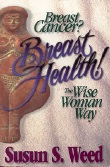
|
Breast Cancer? Breast Health!
Author: Susun S. Weed.
Foods, exercises, and attitudes to keep your breasts healthy. Supportive complimentary medicines to ease side-effects of surgery, radiation, chemotherapy, or tamoxifen. Foreword by Christiane Northrup, M.D. 380 pages, index, illustrations.
Retails for $21.95
Order at: www.wisewomanbookshop.com
|
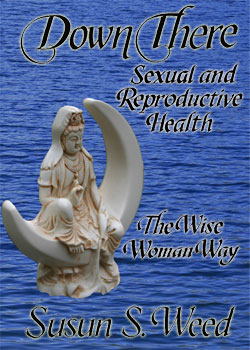
|
Down There: Sexual and Reproductive Health the Wise Woman Way
Publication date: June 21, 2011
Author: Susun S. Weed
Simple, successful, strategies cover the entire range of options -- from mainstream to radical -- to help you choose the best, and the safest, ways to optimize sexual and reproductive health.
Foreword: Aviva Romm, MD, midwife, 484 pages, Index, illustrations.
Retails for $29.95
Order at: www.wisewomanbookshop.com
|
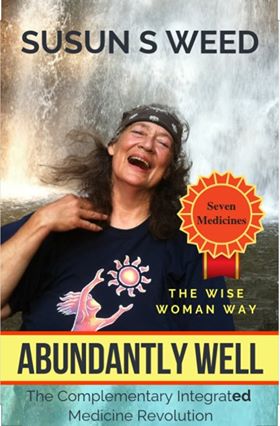
|
Abundantly Well - Seven Medicines
The Complementary Integrated Medical
Revolution
Publication date: December 2019
Author: Susun S. Weed
Seven Medicines build foundational health and guide you to the best health care when problems arise.
Includes case studies, recipes, exentsive references and resources. Introduction by Patch Adams illustrated by Durga
Yael Bernhard 352 pages, index, illustrations
Retails for $24.95
Order at: www.wisewomanbookshop.com
|
|
|
|
Wise Woman Herbal Ezine is sponsored by
www.susunweed.com and www.wisewomanbookshop.com
HEALING WISE | Q & A with SUSUN | GREEN BLESSINGS
THE LIBRARY | PEOPLE MAKING CHANGE | GODDESS ART GALLERY
©Susun
Weed -Wise Woman Center
~ Disclaimer & Privacy Policy ~
|


 Becoming intimate with an herb or a person helps us build trust. How reliable is the effect of this herb? When? How? Where does it fail? Using simples helps us build a web of green allies that we trust deeply. Simples help us feel more powerful. They help abate our fears, simply, safely.
Becoming intimate with an herb or a person helps us build trust. How reliable is the effect of this herb? When? How? Where does it fail? Using simples helps us build a web of green allies that we trust deeply. Simples help us feel more powerful. They help abate our fears, simply, safely.







